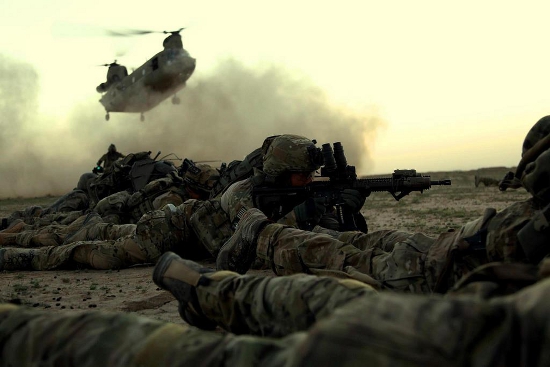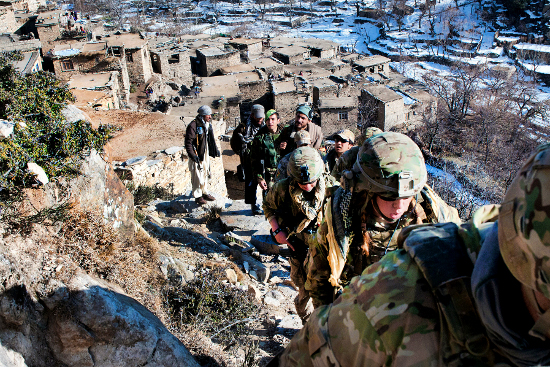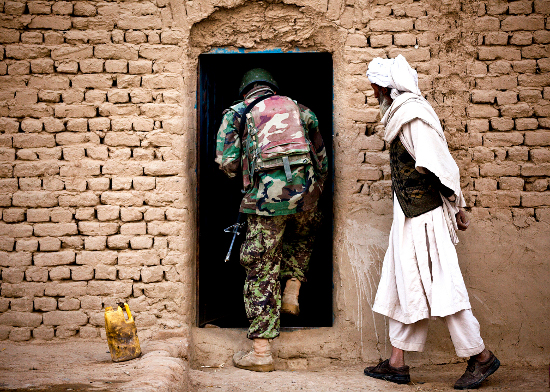BY JODIE SINNEMA, POSTMEDIA NEWS FEBRUARY 27, 2012
Keith Ross, physcial therapist at the Canadian Forces base has been working with Brock since he returned. Pte. Brock Blaszczyk will be in the CAREN (computer assisted rehabilitation) suite at the Glenrose Rehabilitation Hospital, going through a therapy session on the huge computerized system in Edmonton, Alta. One leg is damaged and the other is amputated from above the knee from stepping on an IED in Afghanistan.
Photograph by: Candace Elliott , Edmonton Journal
EDMONTON — Paul Franklin says he was in the best shape of his life when he nearly died.
He was a 200-pound marathoner, mountain climber, medic and master corporal in Afghanistan when a bomb exploded his G-wagon on Jan. 15, 2006, killing diplomat Glyn Berry and ripping off Franklin's left leg and mangling his right. Tourniquets and his team saved him.
By the time he reached Edmonton two months later, Franklin had gone through 26 surgeries, including amputation of his second leg, and weighed only 132 pounds.
Franklin's loss could have left him a defeated man.
Instead, he chose his next training operation: physical rehab at Edmonton's Glenrose Rehabilitation Hospital.
"As a medic, I knew we were going to have other soldiers come back wounded," Franklin said. "We knew that things had to change and we knew we couldn't keep sending our guys to the States."
Six years later, the Glenrose has become the gold standard in physical therapy for the military.
"In Canada, Glenrose stands out like a 2009 Lamborghini on a car lot dotted with far too many 1970 Ladas," reads a 2008 senate committee report entitled Bringing Our Wounded Home Safely. "It is the committee's belief that Canadian military personnel wounded in the service of their country should receive one standard of rehabilitative treatment when they return home: first class."
At the Glenrose, wounded soldiers have pushed the prosthetics and orthotics team to test the boundaries of artificial limbs and braces. War has brought millions of dollars in technology, including an entire computerized therapeutic room that projects virtual worlds onto huge screens to test the ability of the injured to walk.
Afghanistan has even spurred the establishment of Canada's first Military and Veterans' Chair in Clinical Rehabilitation at Edmonton's University of Alberta, a position that aims to drive academic research across Canada in the areas of pain, post-traumatic stress disorder, amputees and robotics.
When Franklin arrived at the Glenrose, his fellow patients were seniors who had lost their limbs through diabetes and other diseases. The treatment team, led by Dr. Jacqueline Hebert, aimed to teach the older patients basic life skills: transferring from their wheelchairs to the toilet, walking and getting in and out of their vehicles.
Franklin wanted far more.
"We challenged each other," he said of Hebert. "She had a patient who was stubborn, wouldn't listen, and wouldn't accept that I would only get six to eight weeks of treatment. In other words, I was willing to say, 'I want to learn to run, I want to learn to have a life again and I want to continue to serve in the military.'"
Hebert's first response: "Your expectations are way off-base." Especially considering Franklin had to relearn how to sit up. He had to stand using his hips and core muscles, balancing as if on a gyroscope on bendy metal stilts that had no feeling of the floor and no flex in the ankle. That alone took him a month.
"When you have a patient who is highly motivated and wants to get back to 200 per cent, you need to temper their expectations, so we spend time doing that, slowing them down, calming them down and reminding them that rehab is a step-by-step process," Hebert said.
But she's also learned from military people to dream bigger.
"I actually think that maybe, sometimes, we would stop too early in the steps in the past," Hebert said. "What we realized is we could go on with their desires rather than tempering them. We tend to let people try more often now. I say 'no' much less than I used to (and) you let them sometimes fail."
That new attitude has spilled over to the general patient population, too. If older patients want to golf or downhill ski, they can try if they want.
"They don't have to be happy with just getting back to work and walking around the house," Hebert said. "It's opened up the understanding that we want people to get back to more things in the community and we want them to know right at the start that it's a possibility."
Walking with artificial legs was crucial for Franklin, even though he will likely never use them without canes, substantial nerve pain and occasional falls. He largely uses them at public speaking engagements and to travel.
"I just saw it as a new challenge, as a new way to train," Franklin said. "That's one of the reasons I was successful at it, because it was a new me, a new normal. . . . It gives me a huge sense of freedom that someone using a wheelchair will never have."
Franklin admits running was beyond his new normal, since he had to swing the carbon fibre Cheetah blades awkwardly with each stride, with no knee to pull them up and under.
But he said the specialized technology at the Glenrose taught him to walk with some grace. He watched himself walking on video recordings and computers, his movement tracked through adhesive markers placed on his skin.
"If I didn't have that, I wouldn't be able to walk as well as I do today," Franklin said. "I would be much more clunky, much more ineffective, with much less ability, to be honest."
While the gait technology was available before Afghanistan and without military dollars, the military bumped up its efforts at the Glenrose as more injured returned home, even paying for a part-time prosthetic and orthotist technician for three years.
"Ten years ago was pre-Afghanistan. Ten years ago was pre-Iraq, the big involvement," said Mike Stobbe, who started working as a prosthetist at the Glenrose a decade ago. Military interest rose in 2004, when American casualties spiked, Stobbe said. That changed the goal in rehab from getting a person back to an acceptable level of function to helping young soldiers move beyond.
"These guys are all athletes," Stobbe said. "They've worked really hard. They've protected us. They've represented us in dangerous ways. What can we do to help them the maximal way?"
Following a visit to Washington's Walter Reed Army Medical Center by a Glenrose rehab team and military contingent, soldiers became eligible for three prosthetics rather than one.
C-legs, for instance, couldn't be used for sailing or quadding because the microprocessor knee can't get wet, Stobbe said. Some chose swimming legs with flippers, while others chose a short stubby with a tiny, sticky climbing shoe at the end to cling to a rock surface.
"All of a sudden, all the upper-end technology was available," Stobbe said.
Many patients who had legs that didn't function properly turned down traditional hard plastic ankle and foot orthotics made for walking. Some soldiers demanded the light carbon-fibre version that would allow them to run.
More therapeutic tools became available when Hebert and her team asked the military for equipment used commonly by American therapists. The list included more treadmills, rowing and biking machines and balancing devices that pushed patients further.
"The real tweak is that (the American military therapists) treat their patients all like athletes and they treat even their severe injuries and amputations like sports injuries," Hebert said. "So they would take their trans-tibial (below the knee) amputees and treat them like they had an ankle sprain. And their above-knee amputees, they treat them like they've had a blown ACL (anterior cruciate ligament) repair."
"It's a different way of looking at your patient, not as missing a body part but as having a new body part," Hebert said. "That's what opened our eyes the most."
After that, instead of gym exercises, patients were sent outside to tie a fly and cast a line for fly fishing to improve manual dexterity. Instead of rowing machines, patients went to the swimming pool with a kayak.
"The military really encouraged and helped us a lot," Stobbe said. "Paul Franklin was really upfront and getting the awareness out there: How can people help the Glenrose? How can the military help us help people better?"
In June 2011, $1.5 million from the Department of National Defence equipped the Glenrose with a computer-assisted rehabilitation environment system, called the CAREN. Another went to Ottawa for eastern Canadians.
Cpl. Brock Blaszczyk, 22, uses the Edmonton system every week, strapped in as he stands on a round movable platform in front of a giant video screen.
No need to head outside in -30 C to climb snow hills and risk falling. Patients practise walking along virtual paths, driving virtual boats and reaching for virtual tools in their garages as their physiotherapists monitor progress.
Blaszczyk's running orthotic on his left leg isn't the problem. His foot was blown off April 3, 2010, when his team was walking along mud walls in search of explosives.
Doctors later amputated the leg halfway through the knee.
The blast took 55 per cent of the soft tissue and 88 per cent of the nerves on the calf of his right leg. To make his right foot work, his Achilles tendon had to be lengthened and his tibia and fibula shortened.
"I'm doing this Terry Fox thing right now, the Terry Fox hop," Blaszczyk said. "It's just a flat trail, and it's run as hard as you can for 200 metres."
Blaszczyk wasn't a runner before, but he misses being able to dash to catch a runaway grocery cart. He's progressed to a fast walk.
"I look a little more like I'm jogging than a penguin hobble. The form is getting better."
He said sometimes the civilian physiotherapists are too cautious. When he practises in the field house at the Edmonton Garrison, his military fitness specialist uses no straps.
"If you're so trusting on being harnessed in, there's no real point in progressing," Blaszczyk said. "The military physios . . . they know that us military guys, we don't mind getting a few scrapes and bruises. That's always how we've been. We don't mind taking a tumble here and there."
Cpl. Mark Fuchko of Calgary, who lost his legs in Afghanistan in 2008, trained to climb Mount Kilimanjaro in 2011 on the CAREN'S 18-degree slopes. More virtual worlds are being invented by students from the Northern Alberta Institute of Technology and the U of A.
"In rehab, technology is the way of the future," Hebert said. "It's amazing the leaps and bounds, the way things have expanded in the last five to 10 years."
But will such technological leaps fall back as Canada pulls out of Afghanistan?
"With Vietnam, which was a similar experience, they did taper off," Stobbe said, noting that studies on amputees and prosthetics changed dramatically between 1968 and 1973. "We glided on that for years and years and years. That could happen, but I think now there is so much more awareness in society of disabled people, period, that they don't disappear anymore."
Andreas Donauer, an orthotist who builds and modifies braces, said while the push isn't as strong, the promise of possibility is.
"It's like you open a door to a new world (and) you realize, OK, there's more to explore yet," Donauer said. "What the military did is just open that door. We have to explore the new world."
That's already happening at the Glenrose, where Hebert and a group are testing bionic limbs through what is called targeted muscle and sensory reinnervation. Operations have already been carried out on amputees, including on a military veteran who lost his arm following a car crash.
Surgeons find the nerves that formerly opened and closed the hand, then plug them into the patient's biceps and triceps to regrow. The veteran is then literally armed with an intuitive prosthesis. When he thinks about moving his arm, the action happens instinctively.
Similar work is being done to give patients the sensation of feeling and touch when they pick something up.
"We are within reach of having real bionic arms that can feel," Hebert said. "It's unbelievable. It's a far greater level of advancement than we ever would have seen, and we do have the U.S. military to thank for that and their extensively funded research programs."
Yet Franklin said it's not the technology or the CAREN system alone that makes the Glenrose the luxury sports car of rehab medicine.
"As with anything, if you have good physios and a good doctor and a good prosthetic guy, you don't need a computer, you don't need any of that good stuff."
Plus, the army guys are covered, he said, and don't need more specialized centres than the ones near military bases.
"We can get the care we want with a computer or without a computer. It's just a tool. But that will help the civilians and help the medical system more than anything else and that's was the idea with all of us: you focus on these (existing) centres, make them better.
"It's actually not for the army guys, it's for civilians."
Edmonton Journal
jsinnema@edmontonjournal.com
© Copyright (c) Postmedia News












